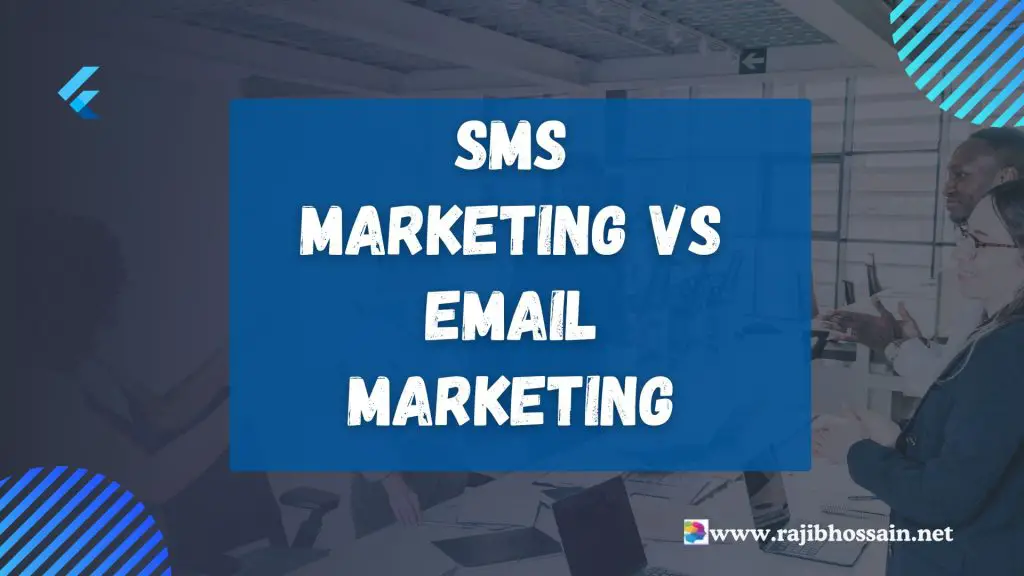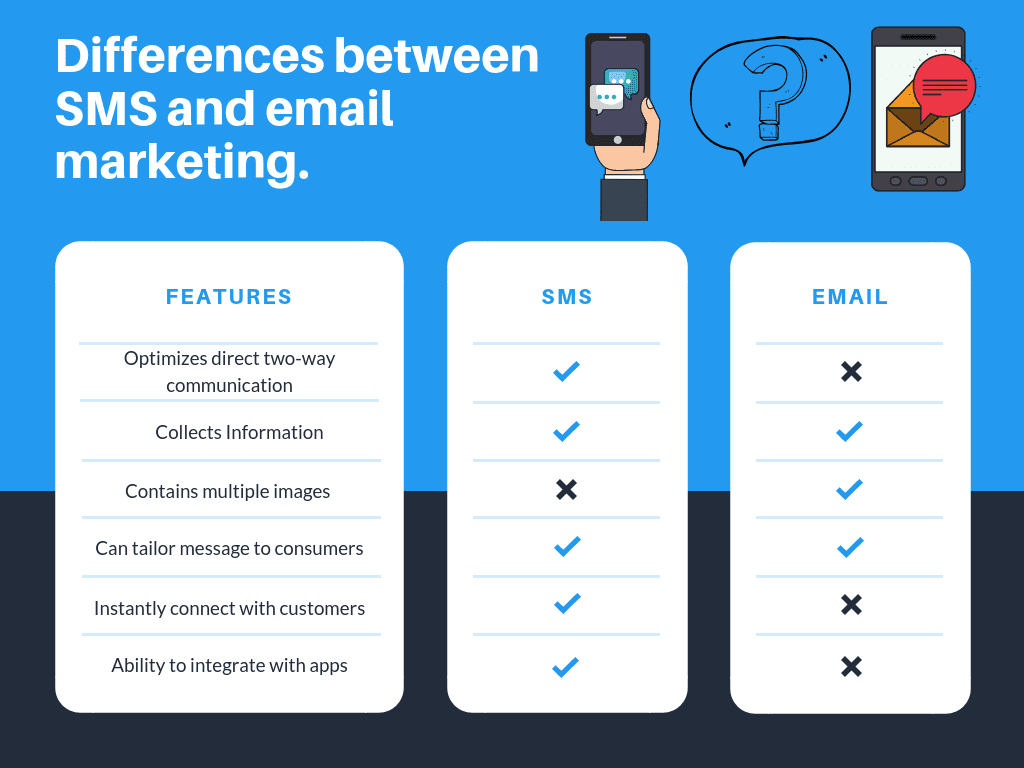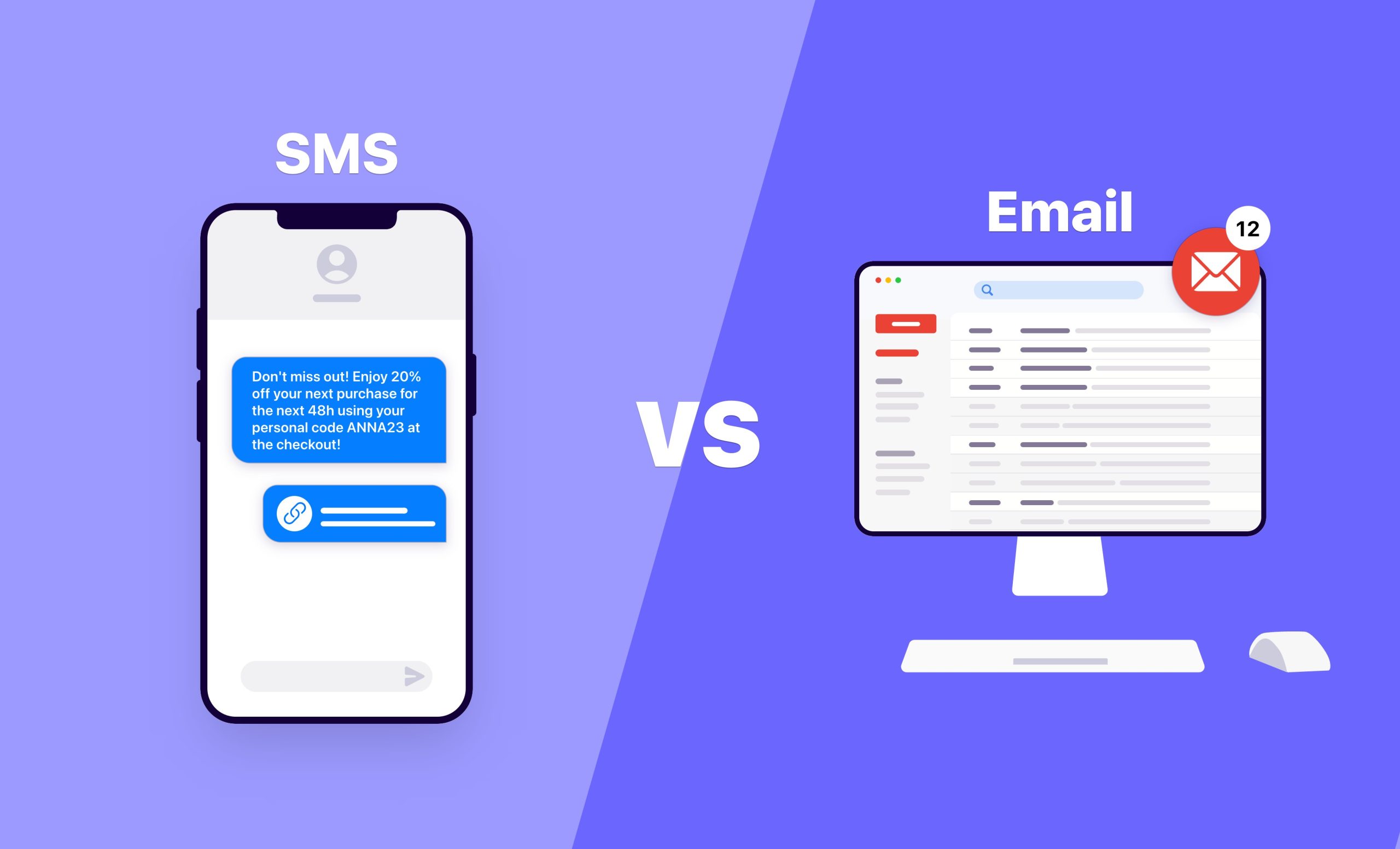
SMS marketing offers immediate reach with high open rates, while email marketing provides more content flexibility and depth. Both strategies have unique advantages for businesses.
SMS marketing involves sending short, targeted messages directly to consumers’ mobile devices. It boasts high open rates and quick delivery, making it ideal for urgent updates and promotions. Email marketing, on the other hand, allows for more detailed content, including images and links, and is effective for nurturing leads over time.
It is cost-effective and offers comprehensive analytics. Choosing between SMS and email marketing depends on the business goals, audience, and the type of message being communicated. Combining both can create a more robust and effective marketing strategy.
Introduction To SMS Marketing Vs Email Marketing
In today’s digital age, marketing channels are evolving rapidly. SMS and email marketing are two powerful tools. Both help businesses reach their audience. Understanding these tools is crucial for any marketer.
The Rise Of Digital Marketing
Digital marketing has grown significantly over the years. More people use the internet daily. Businesses must adapt to this change. Digital marketing offers many benefits. It is cost-effective and has a wide reach. SMS and email marketing are key components of this strategy.
Basics Of Sms And Email Channels
SMS marketing involves sending text messages. These messages are short and direct. They reach users on their mobile phones. Email marketing involves sending messages via email. These emails can be longer and more detailed.
Both channels have their strengths. Let’s compare them in a table:
| Feature | SMS Marketing | Email Marketing |
|---|---|---|
| Message Length | Short (160 characters) | Long (up to several pages) |
| Engagement Rate | High | Moderate |
| Delivery Speed | Instant | Varies (can be instant) |
| Cost | Low | Low |
| Personalization | Limited | High |
Each method has its unique benefits. SMS is quick and direct. Email allows for detailed content. Choose the method that fits your needs best.
Key Features Of Sms Marketing
SMS marketing offers unique benefits that can boost your business. It ensures messages reach customers quickly and effectively. Let’s explore the key features of SMS marketing.
Instant Deliverability
SMS messages are delivered instantly. This ensures your message reaches the audience without delay. Businesses can send time-sensitive offers with confidence. SMS marketing is a powerful tool for urgent updates and promotions.
High Open Rates
SMS messages have very high open rates. Most people check their texts within minutes. This ensures your message gets seen almost immediately. Customers rarely ignore SMS notifications. This makes SMS marketing highly effective for important communications.
Here is a quick comparison of SMS and email open rates:
| Marketing Method | Open Rate |
|---|---|
| SMS Marketing | 98% |
| Email Marketing | 20% |
SMS marketing stands out with its impressive open rates. This ensures your marketing efforts are not in vain.
Key Features Of Email Marketing
Email marketing is a powerful tool for reaching your audience. Let’s explore the key features that make it so effective.
Creative Flexibility
Email marketing allows for extensive creative freedom. You can design visually appealing emails that grab attention. Use images, videos, and graphics to engage your readers. HTML and CSS can help you create custom designs. This flexibility helps you align emails with your brand identity.
- Customizable templates
- Rich media support
- Personalized content
Detailed Analytics
Email marketing provides detailed analytics. Track open rates, click-through rates, and conversions. Understand which emails perform best. Use this data to improve future campaigns. Analytics help you understand your audience better.
| Metric | Description |
|---|---|
| Open Rate | Percentage of opened emails |
| Click-Through Rate | Percentage of clicked links |
| Conversion Rate | Percentage of completed goals |
Use these metrics to refine your strategy. Improve engagement and achieve better results.
Pros And Cons Of Sms Marketing
SMS marketing is a direct way to reach customers. It offers unique advantages and some limitations. Let’s explore the pros and cons of SMS marketing in detail.
Direct Customer Reach
One of the biggest advantages of SMS marketing is direct customer reach. People always carry their phones. This ensures your message is seen almost instantly.
- High Open Rates: SMS messages have a 98% open rate.
- Immediate Delivery: Messages are delivered in seconds.
- Personal Connection: Customers feel a personal touch.
This direct reach helps in quick communication. It is beneficial for urgent updates and offers.
Limited Message Length
One major limitation of SMS marketing is the message length. You can only send 160 characters in one SMS.
- Concise Messaging: Your message must be brief and to the point.
- Limited Information: You can’t share detailed information.
- Creative Constraints: Limited space restricts creativity.
This makes it challenging to convey complex messages. You need to be very clear and concise.
Pros And Cons Of Email Marketing
Email marketing remains a powerful tool for businesses. It offers a range of benefits and challenges. Understanding the pros and cons helps in making informed decisions.
Cost-effectiveness
Email marketing is often more affordable than other methods. Many email marketing services offer tiered pricing. This means you can start small and scale up.
Small businesses can benefit from low-cost campaigns. Large businesses can reach many people at once. This makes email marketing a cost-effective choice.
Potential For Overload
Email marketing can lead to inbox overload. Many people receive numerous emails daily. This can cause your email to be ignored.
- The high volume of emails
- Risk of being marked as spam
- Decreased engagement rates
To avoid overload, it’s crucial to segment your audience. Send targeted emails to specific groups. This helps in increasing engagement.
Here’s a quick comparison:
| Pros | Cons |
|---|---|
| Cost-effective | Risk of overload |
| Scalable | Can be ignored |
| High ROI | Spam risks |
Comparative Analysis: Engagement And Conversion Rates
Understanding engagement and conversion rates is key in marketing. SMS and email marketing are two powerful tools. Both have strengths and weaknesses.
Engagement Metrics
Engagement rates vary between SMS and email marketing. Here is a comparison:
| Metric | SMS Marketing | Email Marketing |
|---|---|---|
| Open Rate | 98% | 20% |
| Response Rate | 45% | 6% |
| Click-Through Rate | 36% | 3.1% |
SMS marketing has higher open rates. Most people read texts within minutes. Emails have lower open rates. Many emails go unread.
Conversion Success Stories
Both SMS and email have success stories. Here are some examples:
- SMS Marketing: A retail store sent a flash sale alert via SMS. They saw a 25% increase in sales that day.
- Email Marketing: An online course provider sent a series of educational emails. They saw a 15% increase in enrollments.
Success depends on message relevance. Timely, personalized messages perform best.
Integration Strategies For Maximum Impact
Integrating SMS and email marketing can boost your business reach. Combining these channels offers a cohesive experience. Learn how to maximize impact with these strategies.
Combining Sms And Email Efforts
Combining SMS and email can enhance your marketing efforts. Here are some strategies:
- Use SMS for urgent updates, email for detailed info.
- Send email newsletters, follow up with SMS reminders.
- Offer exclusive deals via SMS, detailed offers via email.
- Segment your audience for targeted SMS and email campaigns.
| SMS | |
|---|---|
| Urgent alerts | Newsletters |
| Short updates | Detailed information |
| Exclusive deals | Promotional offers |
Cross-channel Marketing Campaigns
Cross-channel marketing blends SMS and email strategies. This approach ensures consistent messaging. Here are some key tactics:
- Start with an email campaign, then use SMS for reminders.
- Promote events via email, send last-minute updates via SMS.
- Use SMS to confirm email sign-ups and subscriptions.
- Track user behavior to optimize SMS and email timing.
Cross-channel marketing ensures your message reaches your audience. Use both SMS and email for a unified campaign. This approach boosts engagement and conversion rates.
Industry-specific Case Studies
Industry-specific case studies highlight the effectiveness of SMS and email marketing. Different industries have unique needs and customer behaviors. Comparing these two marketing tools reveals insights valuable for tailored strategies.
Retail Sector Insights
Retailers often use both SMS and email marketing. Each has its strengths for specific goals.
| Aspect | SMS Marketing | Email Marketing |
|---|---|---|
| Open Rates | 95% | 20% |
| Click-Through Rates | 36% | 3% |
| Conversion Rates | 5% | 2% |
Retailers use SMS for flash sales and urgent updates. Its high open rate ensures quick visibility. Email marketing is ideal for detailed content. Newsletters and product announcements perform well via email.
Example: A clothing brand used SMS to announce a 24-hour sale. They saw a 20% increase in sales. The same brand used email for a monthly newsletter. It provided style tips and new arrivals. The email had a high engagement rate but lower immediate sales impact.
Service Industry Trends
Service-based businesses also benefit from SMS and email marketing. Their approaches differ based on customer needs.
- Appointment Reminders: SMS is preferred for its immediacy.
- Service Updates: Email is used for detailed information.
- Customer Feedback: Both channels are effective.
Example: A dental clinic sends SMS reminders for appointments. This reduces no-shows by 30%. They use email to share dental health tips. This builds trust and educates patients. Both channels together improve overall patient engagement.
Another example is a fitness center. They use SMS for class updates and cancellations. Email is used to send monthly workout plans. This combination ensures members are informed and engaged.
The Future Of Sms And Email Marketing
The digital marketing landscape is evolving fast. SMS and email marketing are still strong contenders. Both have their unique strengths. But what does the future hold?
Emerging Technologies
New technologies are changing SMS and email marketing. Artificial Intelligence (AI) and Machine Learning (ML) are key players. These tools can help personalize messages.
Imagine sending an SMS with a customized offer. Or an email with tailored content. AI and ML make this possible. They analyze data to predict user behavior. This leads to more effective campaigns.
Another technology to watch is automation. Automated campaigns save time and effort. They ensure messages reach the right audience at the right time. This boosts engagement and conversions.
Predictions And Trends
The future of SMS and email marketing looks bright. Here are some trends to expect:
- Increased Personalization: Personalized messages will become the norm.
- Better Integration: SMS and email will work together seamlessly.
- Interactive Content: Emails will include more interactive elements.
- Enhanced Security: Privacy and security measures will improve.
Marketers will use data more effectively. They’ll create more targeted campaigns. This will lead to higher engagement rates.
SMS will continue to grow. More businesses will use it for customer service. Email will remain a powerful tool. It will be used for detailed information and promotions.
| Technology | Impact on SMS | Impact on Email |
|---|---|---|
| AI and ML | Personalized offers | Tailored content |
| Automation | Timed campaigns | Scheduled emails |
| Security | Enhanced privacy | Improved encryption |
Both SMS and email marketing will continue to evolve. Emerging technologies will drive these changes. Businesses must adapt to stay competitive.

Credit: simpletexting.com
Choosing The Right Strategy For Your Business
Deciding between SMS marketing and email marketing can be tough. Both have unique strengths. Picking the best one depends on your business needs. Let’s explore key factors to help you decide.
Audience Analysis
Understanding your audience is crucial. Do they prefer quick updates or detailed information? SMS is ideal for short, urgent messages. Email works best for longer, detailed content.
Use data to know your audience’s behavior. Check their response rates to SMS and emails. Younger audiences often prefer SMS. Older audiences may lean towards email.
Resource Allocation
Consider your resources. SMS campaigns need a concise message. They usually have higher costs per message. Email campaigns can be more detailed and cost-effective.
Here’s a simple comparison table:
| Factor | SMS Marketing | Email Marketing |
|---|---|---|
| Message Length | Short (160 characters) | Long (unlimited) |
| Cost | Higher per message | Lower per message |
| Open Rate | High (98%) | Moderate (20-30%) |
| Response Time | Fast | Slower |
Balance your budget and goals. For urgent, time-sensitive promotions, SMS might be better. For detailed newsletters and promotions, email is likely the winner.
Best Practices For Effective Campaigns
Creating successful SMS and email marketing campaigns requires attention to detail. Both mediums have their strengths. Following best practices ensures your messages are effective and engaging. Let’s explore the key aspects of personalization, timing, and frequency.
Personalization Techniques
Personalization increases engagement and response rates. Tailor your messages to suit your audience. Use customer data to create personalized content.
- Use Names: Address recipients by their names.
- Segment Audience: Group your audience based on interests and behaviors.
- Custom Offers: Provide offers based on past purchases.
- Dynamic Content: Adjust content in emails based on user data.
Personalization in SMS marketing involves similar strategies. Send relevant messages to specific groups. Use short, concise language in texts.
Timing And Frequency
Timing affects the success of your campaigns. Send messages when your audience is most active. Avoid sending too many messages.
| Channel | Optimal Timing | Suggested Frequency |
|---|---|---|
| SMS Marketing | Weekdays, 10 AM – 7 PM | 1-2 times a week |
| Email Marketing | Tuesdays and Thursdays, 9 AM – 11 AM | 2-3 times a week |
Respect your audience’s time. Avoid sending messages late at night. Monitor engagement metrics to refine your timing and frequency.
Conclusion: Crafting A Balanced Approach
In this section, we will explore how to balance SMS and Email Marketing. Both methods have their strengths and weaknesses. Combining them can offer a powerful marketing strategy. Let’s break down the key points and provide final recommendations.
Summarizing Key Takeaways
- Reach and Engagement: SMS has a high open rate. Email offers detailed content.
- Cost-Effectiveness: Emails are cheaper. SMS can be pricier but effective.
- Personalization: Both allow for personalization. Use customer data wisely.
- Speed: SMS is instant. Emails can be scheduled and tracked.
- Regulatory Compliance: Both require consent. Follow local laws to avoid fines.
Final Recommendations
- Understand Your Audience: Know your customers’ preferences. Some prefer SMS, others email.
- Segment Your Lists: Group customers based on behavior. Tailor messages for each segment.
- Combine Efforts: Use SMS for urgent messages. Use email for detailed information.
- Track Performance: Use analytics to measure success. Adjust your strategy based on data.
- Stay Compliant: Ensure you have permission to contact customers. Respect privacy laws.
By balancing SMS and Email Marketing, you can engage customers effectively. Use the strengths of each method for a successful campaign.
FAQs: SMS Marketing Vs Email Marketing
Which Is Better, Sms Marketing Or Email Marketing?
Both SMS and email marketing have their benefits. SMS offers higher open rates and immediacy. Email allows for detailed content and segmentation. The best choice depends on your goals and audience.
Is Sms Or Email More Effective?
SMS is often more effective for urgent, time-sensitive communication. Email works better for detailed, long-form content and professional communication.
What Is The Main Difference Between Email And Sms?
Email uses the internet to send detailed messages with attachments. SMS sends short text messages via cellular networks.
Is Sms Marketing Still Effective?
Yes, SMS marketing remains highly effective. It boasts high open rates, quick delivery, and strong engagement. Businesses benefit from its direct reach and personalized approach.
Conclusion
Choosing between SMS marketing and email marketing depends on your business goals. SMS offers immediacy, while email provides detailed content. Both channels have unique strengths. Assess your audience’s preferences and campaign objectives. By leveraging both, you can maximize your marketing strategy’s effectiveness and reach.

